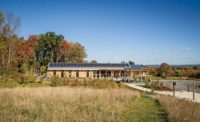ENR 2020 Top 25 Newsmakers
Paul Schwer: Masterminding World's Largest, Most Sustainable and Most Quake-Resistant Living Office Building

Schwer is setting the example for others to build developer-led, investor-driven office buildings that do less harm to the environment.
Photo by Kyle Schwer
After working for Jaros Baum & Bolles for nine years in New York City, mechanical engineer Paul Schwer quit his job, bought a Jeep and traveled the U.S. for six months with his wife, Joyce. Seeking a place to resettle, they ended up in the Pacific Northwest, where Schwer landed a position at consulting engineer PAE in Portland, Ore. That was nearly 27 years ago.
“There is something really profound about walking among trees older than the country,” says Schwer, who remains drawn to the Columbia River Basin with its old-growth forests.
Schwer’s awe of trees is not the main reason the mechanical engineer is personally investing—separate from team member-investors PAE, ZGF Architects and Walsh Construction Co./OR—in the mass-timber-framed PAE Living Building. But the sustainable framing material does get points for sequestering carbon. Beyond wood, the 58,000-sq-ft PAE, set to open in September with PAE also as its main tenant, is on deck to be the largest, most resilient and most sustainable speculative office building certified under the Living Building Challenge.
For Schwer, the project is the culmination of a strong commitment to minimize negative environmental impacts. “As the first developer-led, investor-driven Living Building, we hope to be a model for others,” says PAE’s president since 2004.
Schwer’s own model for sustainability is the 52,000-sq-ft Bullitt Center in Seattle—the first and largest spec office building to achieve Living Building status. Project mastermind Denis Hayes, as president of the environmental nonprofit the Bullitt Foundation, selected Schwer for the job and swayed him to open PAE’s Seattle office in the building. Hayes sings Schwer’s praises, based on his “genius strokes” during Bullitt’s design phase, when energy use and costs were still out of whack.
Hayes, also the organizer of the first Earth Day, wanted an “irresistible stairway,” to draw occupants away from elevators. The proposed solution was a glass-enclosed stair with views of the Space Needle and, on the upper levels, the Olympic Mountains.
It was an elegant design but too costly to heat and cool. “My irresistible stairway was starting to look like a black hole,” says Hayes, until Schwer saved the day by suggesting there was no need to heat or cool the stair because it was outside the occupied space. All that was needed was protection from the elements and operable windows to vent hot air out the top. Hayes got his stair.
Schwer and the PAE building team are applying equivalent genius strokes to make the numbers work for the PAE building, which is surpassing Bullitt in sustainability and resilience. Not only is Schwer the mastermind of the PAE project, it was his idea to debut hospital-level quake endurance to avoid business interruption in the event of even a magnitude-7.5 temblor.
To recoup the extra cost of a resilient structure, the team received permission to cozy up closer to its neighbors. The rationale: a resilient structure would sway less in a quake. That meant a larger footprint with more leasable floor area, which would pay for the quake resilience, says Jill Sherman, a partner with project developer Edlen & Co.
The PAE building also will debut fertilizer production from urine—a system that has potential to reduce wastewater in all buildings. “PAE has a reputation for walking the talk about sustainability and a lot of that is Paul’s leadership,” says Sherman.
Schwer grew up on Long Island, N.Y. In 1975, a surprise family visit to an open house at Brookhaven National Laboratory sparked his interest in renewable energy. “We were returning from a week’s vacation in Montauk, and I thought we were stopping for ice cream,” he says. At the lab, Schwer saw a crude solar collector—a wood box with beer cans and glass. Later, he wrote to the scientist who had built the collector. In return, he received a set of plans for the collector that he used to build a replica for his science project.
Schwer has come full circle and more since this formative experience. Going forward, “PAE and I will be playing a role” in efforts to power the entire West Coast with 100% renewable energy, he says.




